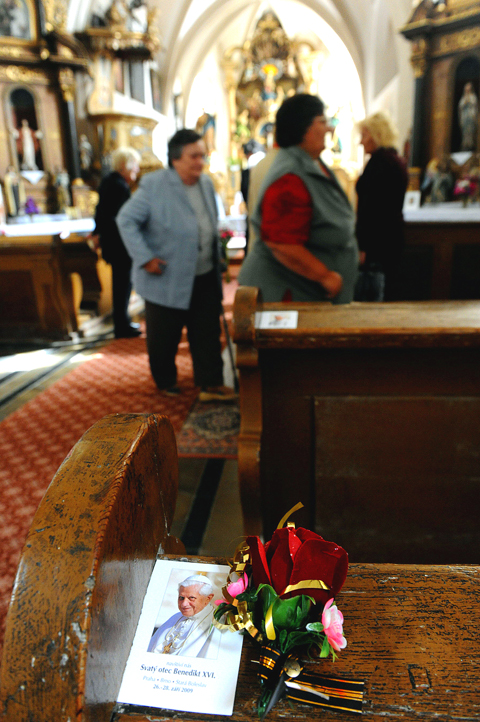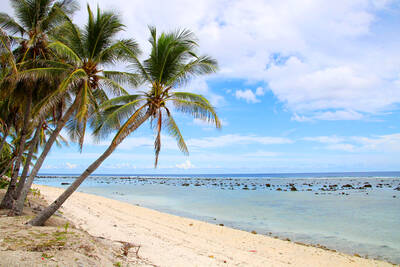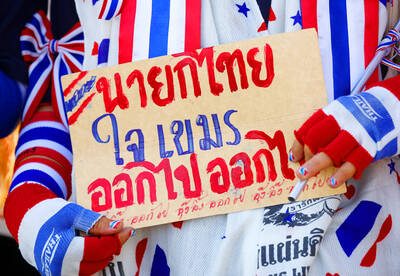Only a large wooden cross resists the ravages of time in a church with a collapsed roof and walls overgrown by wild bushes in the small village of Zlovedice.
The small, neglected village and its dilapidated sanctuary lie in northern Bohemia, the most atheist region in the generally secular Czech Republic, where religion was crushed during World War II and under more than 40 years of communist rule.
“When I came to Zlovedice for the first time, a woman told me: ‘It’s been forty years since I last saw a priest,’” friar Josef Cermak said.

PHOTO: AFP
During his visit to the Czech Republic this weekend, Pope Benedict XVI will stop in Prague, Brno and Stara Boleslav, but not in this borderland region formerly known as the “Sudetenland,” inhabited mostly by ethnic Germans forced to leave their homes after World War II.
“But it is not a God-forsaken region at all,” Cermak said.
“I am proof of this. I’m here, I live with the people,” says the modest 57-year-old friar, who oversees 17 parishes from his seat in Kadan, about 100km northwest of Prague.
But he is quick to point out that some of the parishes exist only “on paper” since many of them were located in deserted villages that have long disappeared from the vast military area surrounding the region.
Religious belief found itself in steady decline in the region following the expulsion of German-born Catholics and then because of the policy of the Czechoslovak communist regime (1948 to 1989), which labeled the Church the people’s enemy.
Jana Michalkova, spokeswoman for the diocese in Litomerice — a town about 80km north of Prague — says about half of the 1,135 churches and chapels in the area are in very poor condition.
“The work of clerics here is much more difficult compared to other parts of the country such as the strongly Catholic southern Moravia,” she said.
“They have to move a lot to be with their parishioners. Sometimes they serve a mass for just one or two people,” Michalkova said.
She said the “intentional liquidation of the Church and its institutions by the former communist regime” was one of the reasons behind the current situation.
The social and economic conditions in the region have also deteriorated since the fall of communism in 1989.
The region flourished under communism owing to a fast-growing heavy industrial sector and coal mining, but once the planned economy collapsed unemployment spiked.
Despite the pitiful condition of St Michael’s Church in Zlovedice, friar Cermak regularly goes there on Good Friday and Christmas Eve “to pray,” as he says, after celebrating a Sunday Mass with about twenty mostly elderly believers in Mastov, another village in the region, with a population of 725.
The Mastov church bears the name of the Assumption of the Virgin Mary — a feast that is celebrated with pomp in neighboring Austria, Poland and Slovakia, while in the Czech Republic it is practically unknown.
A majority 59 percent of Czechs did not identify with any religion in the last census in 2001, up from 39 percent a decade earlier.
Meanwhile, the percentage of believers tumbled from 43.9 percent to 32.2 percent between 1991 and 2001, figures from the Czech Statistical Office showed. But ecclesiastic circles say the data is imprecise, and insist instead that the actual number of people professing to belong to a faith in the 10.2-million-strong Czech Republic is significantly higher.
“According to our statistics, the number of Catholics in our diocese comprising 10 vicarages reaches 280,000 and remains practically unchanged, while the number announced by the statistical office was 160,000,” Michalkova said.

Nauru has started selling passports to fund climate action, but is so far struggling to attract new citizens to the low-lying, largely barren island in the Pacific Ocean. Nauru, one of the world’s smallest nations, has a novel plan to fund its fight against climate change by selling so-called “Golden Passports.” Selling for US$105,000 each, Nauru plans to drum up more than US$5 million in the first year of the “climate resilience citizenship” program. Almost six months after the scheme opened in February, Nauru has so far approved just six applications — covering two families and four individuals. Despite the slow start —

YELLOW SHIRTS: Many protesters were associated with pro-royalist groups that had previously supported the ouster of Paetongtarn’s father, Thaksin, in 2006 Protesters rallied on Saturday in the Thai capital to demand the resignation of court-suspended Thai Prime Minister Paetongtarn Shinawatra and in support of the armed forces following a violent border dispute with Cambodia that killed more than three dozen people and displaced more than 260,000. Gathered at Bangkok’s Victory Monument despite soaring temperatures, many sang patriotic songs and listened to speeches denouncing Paetongtarn and her father, former Thai prime minister Thaksin Shinawatra, and voiced their backing of the country’s army, which has always retained substantial power in the Southeast Asian country. Police said there were about 2,000 protesters by mid-afternoon, although

MOGAMI-CLASS FRIGATES: The deal is a ‘big step toward elevating national security cooperation with Australia, which is our special strategic partner,’ a Japanese official said Australia is to upgrade its navy with 11 Mogami-class frigates built by Japan’s Mitsubishi Heavy Industries, Australian Minister for Defence Richard Marles said yesterday. Billed as Japan’s biggest defense export deal since World War II, Australia is to pay US$6 billion over the next 10 years to acquire the fleet of stealth frigates. Australia is in the midst of a major military restructure, bolstering its navy with long-range firepower in an effort to deter China. It is striving to expand its fleet of major warships from 11 to 26 over the next decade. “This is clearly the biggest defense-industry agreement that has ever

DEADLY TASTE TEST: Erin Patterson tried to kill her estranged husband three times, police said in one of the major claims not heard during her initial trial Australia’s recently convicted mushroom murderer also tried to poison her husband with bolognese pasta and chicken korma curry, according to testimony aired yesterday after a suppression order lapsed. Home cook Erin Patterson was found guilty last month of murdering her husband’s parents and elderly aunt in 2023, lacing their beef Wellington lunch with lethal death cap mushrooms. A series of potentially damning allegations about Patterson’s behavior in the lead-up to the meal were withheld from the jury to give the mother-of-two a fair trial. Supreme Court Justice Christopher Beale yesterday rejected an application to keep these allegations secret. Patterson tried to kill her